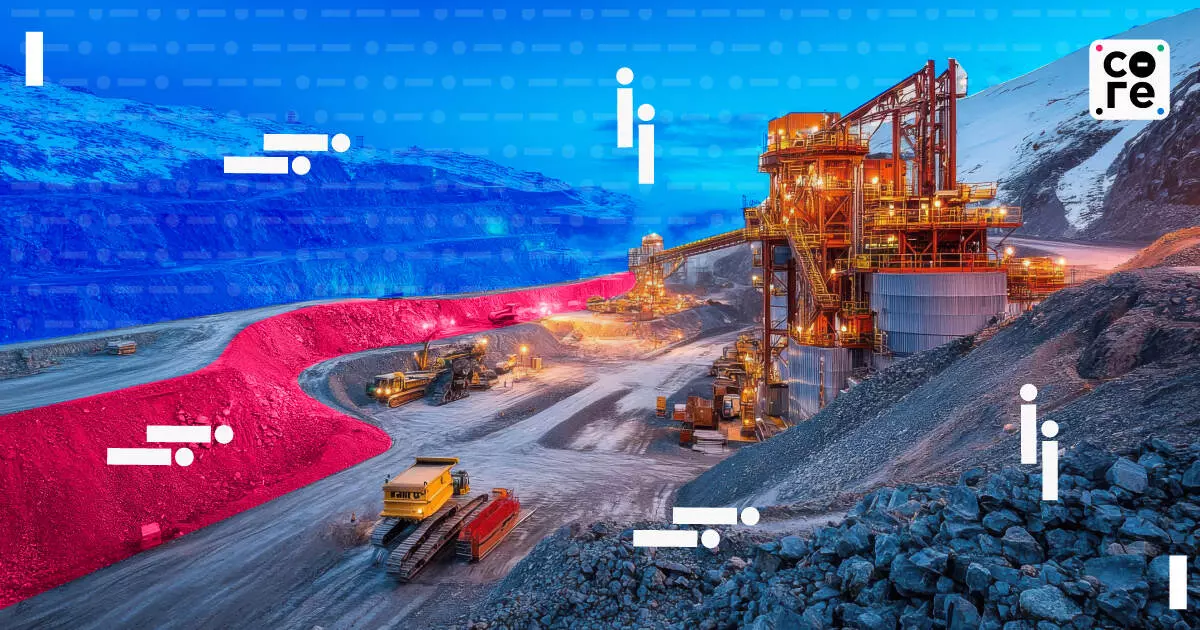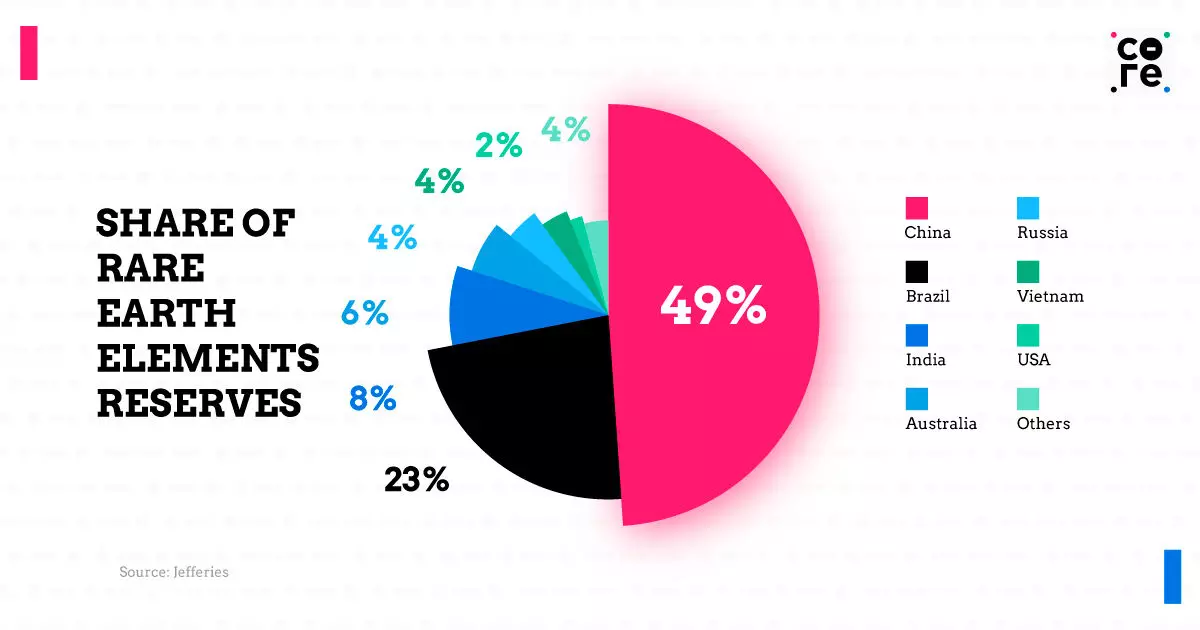
Rare Earth Metals Shortage To Hit India’s ‘Mission Critical Industries’ Beyond Auto
India has 8% of global rare earth elements reserves, but it needs more tech to mine and refine.

Much is being said about how China’s salvo to gatekeep rare earth metals will affect the auto industry. But rare earth metals are critical to semiconductors, wind turbines and medical equipment industries, where India wants to either build export-oriented advantage or manufacture for domestic needs.
A group of 17 metals — including 15 silvery-white metals of the Lanthanide series and two transition metals — these rare metals have a variety of uses.
“From electronics to semiconductors, the entire communications chain — like chips, satellites, telecom as well as defence sector manufacturing requires rare earth metals and compounds,” Rajib Maitra, partner at Deloitte India, told The Core.
The primary utility of rare earth minerals lies in their use for creating permanent magnets, with Na-Fe-B magnets being the strongest among them. The magnets have a variety of uses in auto motors as well as aircraft for propulsion systems, maintaining torque, detecting positions, as well as fluid flow.
“The highest consumption of rare earths might be in wind turbines. Then there is consumer electronics, like mobile phones and others,” informs Nikhil Dhaka, VP of public policy at Primus Partners, a consulting firm.
Apart from magnets, rare earth metals are also used in catalysts, polishing powders, metallurgical uses, glass and ceramics and, battery alloys, among others.
Much is being said about how China’s salvo to gatekeep rare earth metals will affect the auto industry. But rare earth metals are critical to semiconductors, wind turbines and medical equipment industries, where India wants to either build export-oriented advantage or manufacture for domestic needs.
A group of 17 metals — including 15 silvery-white metals of the Lanthanide series and two transition metals — these rare metals have a variety of uses.
“From electronics to semiconductors, the entire communications chain — like chips, satellites, telecom as well as defence sector manufacturing requires rare earth metals and compounds,” Rajib Maitra, partner at Deloitte India, told The Core.
The primary utility of rare earth minerals lies in their use for creating permanent magnets, with Na-Fe-B magnets being the strongest among them. The magnets have a variety of uses in auto motors as well as aircraft for propulsion systems, maintaining torque, detecting positions, as well as fluid flow.
“The highest consumption of rare earths might be in wind turbines. Then there is consumer electronics, like mobile phones and others,” informs Nikhil Dhaka, VP of public policy at Primus Partners, a consulting firm.
Apart from magnets, rare earth metals are also used in catalysts, polishing powders, metallurgical uses, glass and ceramics and, battery alloys, among others.
Strategic Sectors Hit
Aside from electric vehicles (EVs), where India has ambitious expansion plans, many key sectors where India is either trying to build an export base, like semiconductors, or wind turbines, will be affected, possibly derailing its sustainability and net-zero goals.
“The semiconductor sector is likely to be impacted by the restrictions. The India Semiconductor Mission (ISM) has an outlay of Rs 76,000 crore and is expected to cross $100 billion in size by 2030. These plans will see challenges in the shorter term due to any potential restrictions in rare earth supply,” said Maitra.
Over 60% of India’s domestic needs for medical devices are met by indigenous manufacturing, and this will be hit too. The metals are used in MRI scanners, MRAs and PET scans for detailed imaging of the body and to guide radioactive traces. Rare earth metals also find utility in implants, ventilators, insulin pumps and more.
China’s restrictions, however, pertain to end-use more than blanket restrictions. As per reports, as many as 30 Indian companies import rare earths. While EVs and medical devices might find it easier to receive certificates of imports, a burgeoning indigenous defence industry, as well as export-focused semiconductors, might face hurdles.
‘A Global Wake Up Call’
India’s industries minister Piyush Goyal recently termed the restrictions as a ‘global wake-up call’, adding that the country is actively building alternate supply chains.
Rare earth elements are actually a misnomer, as they are fairly abundant in availability. Unlike crude, coal and others, it’s not being overmined either. As much as 390 kilo tonnes was mined in 2024, while the reserves are 230 times the mining – at 90 million tonnes, as per Jefferies. While China holds around half of the reserves, India too has around 8% of the total reserves.
“It's not that rare earths are not present in India. We have the fifth-largest rare earth reserves in the world right now. Across the coastal region of Odisha, Telangana, Andhra, some part of Karnataka, and maybe in other states as well, but majorly these states in the form of monazite,” said Dhaka.
In spite of its share in reserves and production, China has maintained an upper hand, with 69% of rare earth mine production. More importantly, when it comes to refined versions of production, they account for 90% of the production.
Apart from mining, China has also built refining capacities, which is a challenge because these metals are found in low concentrations and mixed with many other metals. While Japan and others built refining capacity, they too are in turn dependent on China due to its dominant presence across the value chain.

Where Does India Stand?
A government miniratna called India Rare Earths Limited is engaged in mining and is also known to have memoranda of understanding (MoUs) with a few companies. But to proceed further, India would require technology transfers as mining these metals that exist in low concentrations, as well as refinin,g would need help.
“We need to maybe set a target of a few pilots, involve the private sector, maybe set a target of 1,000 tonnes by next four years. But it requires a strategic push, similar to what is being done in the semiconductor sector, or for batteries,” said Dhaka.
Most experts also believe that a model has to emerge if India wants to take advantage of the reserves it possesses. “A PLI-like scheme similar to the construct for the solar PV module manufacturing can be replicated with short-term viability gap funding, tax incentives to make them cost competitive. Also, mid and downstream capacities need to be set up as well,” suggested Maitra.
To achieve self-sufficiency, the government launched the National Critical Mineral Mission in 2025, and the Geological Survey of India has been tasked with conducting 1,200 exploration projects in the next five years. As per the mission, the central government has authority over the auction of mining leases and composite licences for 24 critical minerals.
With higher control on resources, India might have taken the big leap for the long term, but in the shorter term, however, it has to depend on Malaysia, Vietnam and more, which produce refined products that can be used across sectors in India.
India has 8% of global rare earth elements reserves, but it needs more tech to mine and refine.

